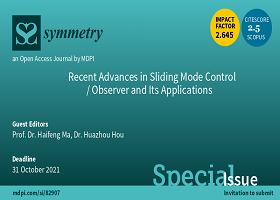Recent Advances in Sliding Mode Control/Observer and Its Applications
A special issue of Symmetry (ISSN 2073-8994). This special issue belongs to the section "Engineering and Materials".
Deadline for manuscript submissions: closed (15 May 2022) | Viewed by 9081

Special Issue Editors
Interests: vibration control; machining monitoring; high-precision motion control
Special Issues, Collections and Topics in MDPI journals
Interests: sliding mode control and its applications
Special Issues, Collections and Topics in MDPI journals
Special Issue Information
Dear Colleagues,
Sliding mode control (SMC) and sliding mode observation (SMO) provide effective ways for designing robust controllers and observers. This Special Issue covers recent advances in both sliding mode control and observation, which includes the following two categories: First, theoretical results on SMC and SMO, including novel design methods for controller and observer, and novel analysis results on the system dynamics of sliding mode systems, such as chattering analysis, discretization effects on the algorithms, frequency analysis, and so forth. The second part focuses on the applications of SMC or SMO in various systems, including power systems, mechatronics systems, power electronics, multiagent systems, underactuated systems, networked control systems, energy systems, and so on. The primary objective of this Special Issue is to provide a forum for researchers and practitioners to share their latest theoretical and technological achievements and to identify critical issues and challenges for future research on SMC/SMO. The submitted papers are expected to share original ideas and potential contributions for theory and application. Please note that your submission must be related to Symmetry.
Prof. Dr. Haifeng Ma
Dr. Huazhou Hou
Guest Editors
Manuscript Submission Information
Manuscripts should be submitted online at www.mdpi.com by registering and logging in to this website. Once you are registered, click here to go to the submission form. Manuscripts can be submitted until the deadline. All submissions that pass pre-check are peer-reviewed. Accepted papers will be published continuously in the journal (as soon as accepted) and will be listed together on the special issue website. Research articles, review articles as well as short communications are invited. For planned papers, a title and short abstract (about 100 words) can be sent to the Editorial Office for announcement on this website.
Submitted manuscripts should not have been published previously, nor be under consideration for publication elsewhere (except conference proceedings papers). All manuscripts are thoroughly refereed through a single-blind peer-review process. A guide for authors and other relevant information for submission of manuscripts is available on the Instructions for Authors page. Symmetry is an international peer-reviewed open access monthly journal published by MDPI.
Please visit the Instructions for Authors page before submitting a manuscript. The Article Processing Charge (APC) for publication in this open access journal is 2400 CHF (Swiss Francs). Submitted papers should be well formatted and use good English. Authors may use MDPI's English editing service prior to publication or during author revisions.
Keywords
- Terminal sliding mode control
- Higher-order sliding mode control
- Sliding mode observer
- Discrete-time sliding mode control
- Adaptive sliding mode control
- Intelligent sliding mode control
- Sliding mode control/observation applications






